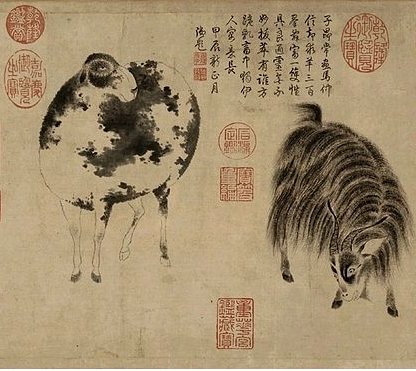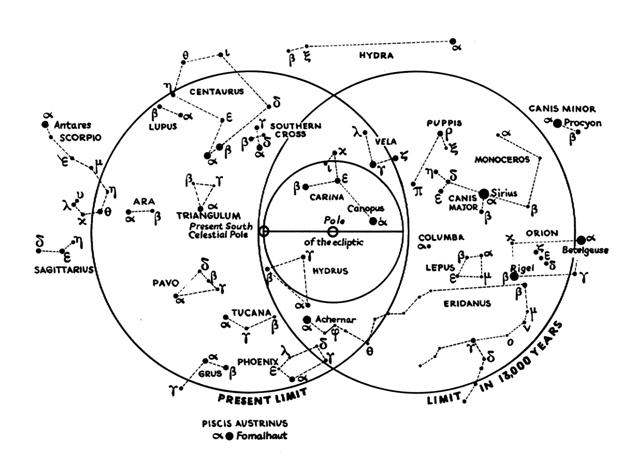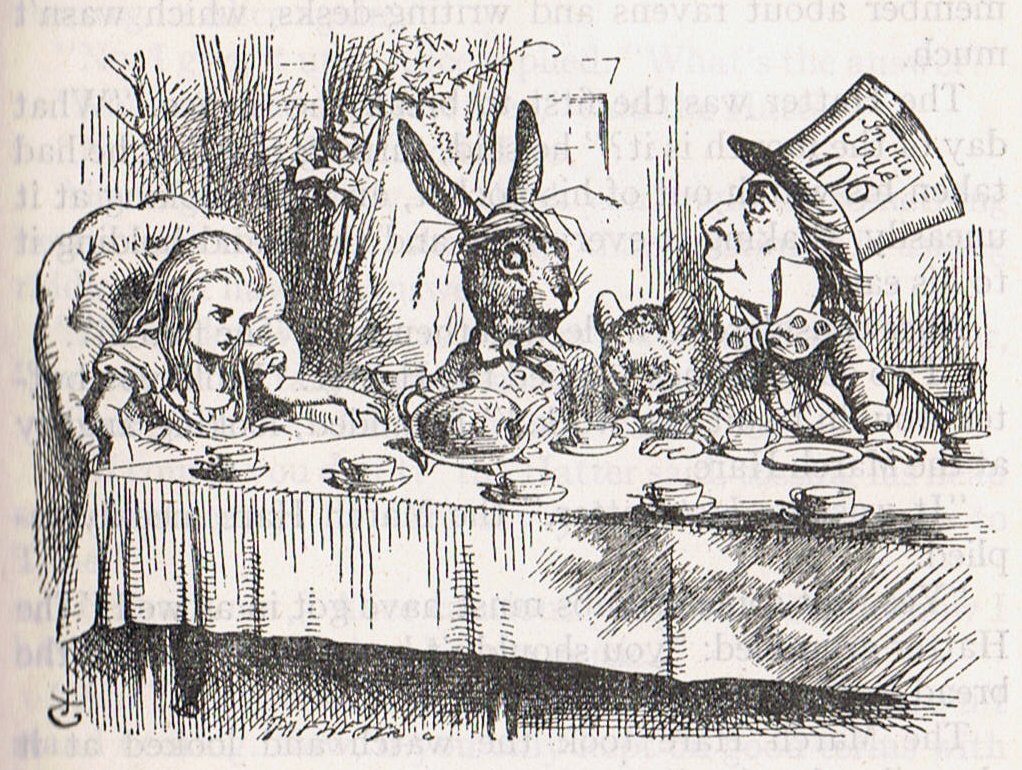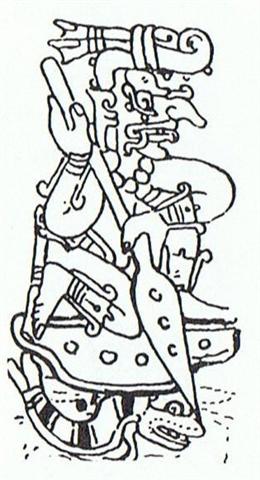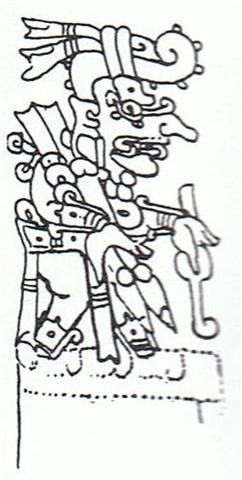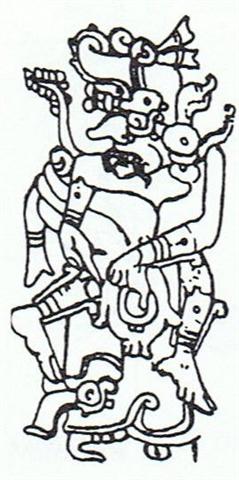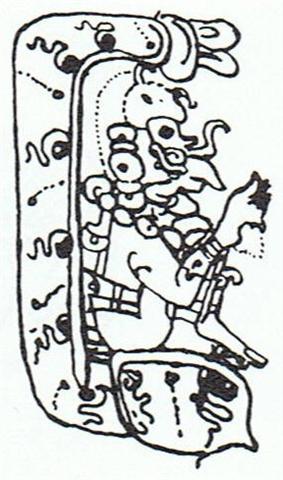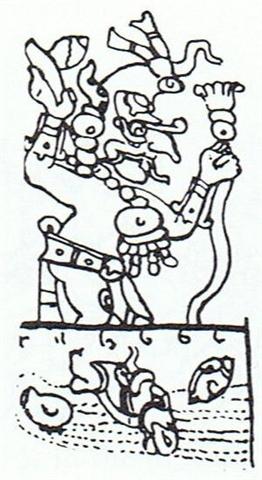Sirius, this most important star, culminated at midnight in February 11, which probably was important not only for the Chorti indians but also for the creator of the G text:
At the opposite side of the Foundation asterism in Aquarius was the Knot (Ukdah) in Hydra. When at the time of Bharani Sirius had reached "June 30 - together with the Sun - also Alphard (α Hydrae) had been there. The Arab Al Tarf means the End. And the Beginning was at Sadalsud (the Luckiest of the Lucky, β Aquarii):
The 13th Babylonian station was Rishu A. (A. here possibly expressing an ancient version of the Arab Asad as in Lion) and in Ga3-23 the head of the fish (on his way to make a downwards haka-turu turn) is emphasized. His mouth has closed and so, presumably, has also his journey. There were no lions on Easter Island, but there were ferocious sharks around: ... Here, in a very condensed form, is a typical Fijian myth of the origin of the current ruling clan (mataqali): A handsome, fair-skinned stranger, victim of an accident at sea, is befriended by a shark who carries him ashore on the south coast of Viti Levu. The stranger wanders into the interior where he is taken in by a local chieftain, whose daughter he eventually marries. From this union springs the line of Noikoro ruling chiefs, the narrator of the story being the tenth descendant on that line. He and his clansmen are called 'The Sharks' (Na Qio) ... It is all as in the Hawaiian proverb: 'A chief is a shark that travels on land' ... (Islands of History) In "June 3 (104 = 2 * 52 days after 0h) haú in Ga3-22 can be understood as referring to the fibres necessary for making a rope with a knot. The Hydra serpent was tied to the top of the mast of the sunken ship of the Argonauts: ... When it was evident that the years lay ready to burst into life, everyone took hold of them, so that once more would start forth - once again - another (period of) fifty-two years. Then (the two cycles) might proceed to reach one hundred and four [104] years. It was called 'One Age' when twice they had made the round, when twice the times of binding the years had come together ...
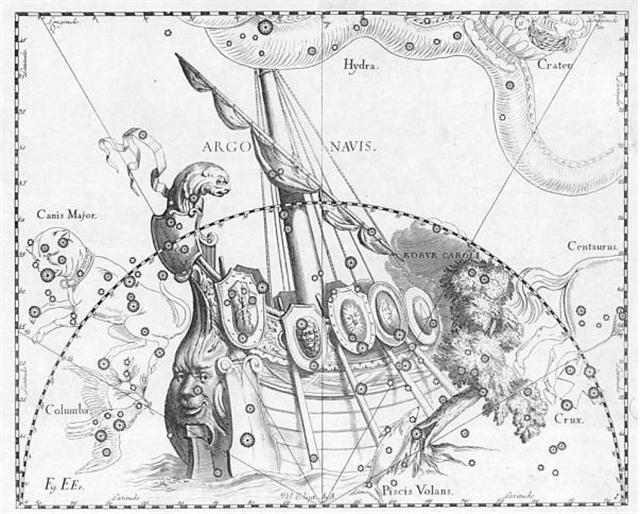 The very bright Vega (once upon a time a north Pole star) had culminated in "June 3 (184). And at that ancient time the brightest star of them all, Sirius, had culminated at midnight half a year away, in "January 1 (366).
February 14 is still remembered as All Hearts' Day (St Valentine's day) and in addition to our usual associations knotted to this date we can now add the idea of a beginning for all the cycles - as we know from the corresponding Hathor 'heart': ... In the inscriptions of Dendera, published by Dümichen, the goddess Hathor is called 'lady of every joy'. For once, Dümichen adds: Literally ... 'the lady of every heart circuit'. This is not to say that the Egyptians had discovered the circulation of the blood. But the determinative sign for 'heart' often figures as the plumb bob at the end of a plumb line coming from a well-known astronomical or surveying device, the merkhet. Evidently, 'heart' is something very specific, as it were the 'center of gravity' ... See Aeg.Wb. 2, pp. 55f. for sign of the heart (ib) as expressing generally 'the middle, the center'. And this may lead in quite another direction. The Arabs preserved a name for Canopus - besides calling the star Kalb at-tai-man ('heart of the south') ... Suhail el-wezn, 'Canopus Ponderosus', the heavy-weighing Canopus, a name promptly declared meaningless by the experts, but which could well have belonged to an archaic system in which Canopus was the weight at the end of the plumb line, as befitted its important position as a heavy star at the South Pole of the 'waters below'. Here is a chain of inferences which might or might not be valid, but it is allowable to test it, and no inference at all would come from the 'lady of every joy'. The line seems to state that Hathor (= Hat Hor, 'House of Horus') 'rules' the revolution of a specific celestial body - whether or not Canopus is alluded to - or, if we can trust the translation 'every', the revolution of all celestial bodies. As concerns the identity of the ruling lady, the greater possibility speaks for Sirius, but Venus cannot be excluded; in Mexico, too, Venus is called 'heart of the earth' ...
"At a rather isolated place at the edge of the desert, about 2.5 kilometers ... south-west of the modern town, lies what Dendera is famous for, a mostly Graeco-Roman temple complex known in ancient Egyptian as Iunet or Tantere. The modern Arab town is built on the ancient site of Ta-ynt-netert, which means 'She of the Divine Pillar'. It was once the modest capital of the 6th Nome (Pharaonic province) of Upper Egypt, and was also called Nikentori or Nitentori, which means 'willow wood' or 'willow earth'. Some scholars believe the name derives from the sky and fertility goddess Hathor, also associated with the Greek Aphrodite, who was especially worshiped there. The official deity of the city was a crocodile ..." (Wikipedia)
There is a price label which could allude to June 10:
... The month, which takes its name from Juppiter the oak-god, begins on June 10th and ends of July 7th. Midway comes St. John's Day, June 24th, the day on which the oak-king was sacrificially burned alive. The Celtic year was divided into two halves with the second half beginning in July, apparently after a seven-day wake, or funeral feast, in the oak-king's honour ... APRIL 21 (111) + 183 - 80 = *214 (alluding to FEBRUARY 14):
Another interpretation of the price label in the quick-silver man's hat is to read 106. This number is one less than 107 = 472 (= 8 *59) - 365 (days in a year). But if we count only the glyphs and not my assumed vacant glyph space at the beginning of side a, then the number becomes 471 (= 1½ * 314) = 365 + 106. It could mean the circuit is 106 days longer than a year and ending at June 10 (10-6). At the time of Bharani (the place of birth) - a time before the Jumping One (the March Hare) - there were 2 'wings' (for instance both a morning and an evening Venus and both a first and a second half of the basic time period 59 nights). ... They tightly swathed the broken body in linen bandages, and when they performed over it the rites that thereafter were to be continued in Egypt in the ceremonial burial of kings, Isis fanned the corpse with her wings and Osiris revived, to become the ruler of the dead. He now sits majestically in the underworld, in the Hall of the Two Truths, assisted by forty-two assessors, one from each of the principal districts of Egypt; and there he judges the souls of the dead ... ... Rehua has been variously identified with Jupiter by Tregear, with Sirius by Stowell, and with Antares by Best, and there can be no doubt that the name was applied to different objects in various sections of New Zealand. An old native declared: 'Rehua is a star, a bird with two wings; one wing is broken. Under the unbroken wing is Te Waa-o-Tamarereti (the Canoe of Tamarereti is the Tail of Scorpius in this instance). When Rehua mates with his wife Pekehawani (a star close to Antares) the ocean is windless and motionless.' Antares, visible in the morning sky of December-January, came to stand for summer heat; hence the saying, 'Rehua cooks (ripens) all fruit'. The generally accepted version of the Rehua myth, according to Best, is that Rehua had two wives, the stars on either side of Antares. One was Ruhi-te-rangi or Pekehawani, the personification of summer languor (ruhi), the other Whaka-onge-kai, She-who-makes-food-scarce before the new crops can be harvested ... ... The cock performs with his wings, alternating wing beats, until he attracts a mate. They will go to the mating area and he will maintain privacy by driving away all intruders. They graze until their behaviour is synchronized, then the feeding becomes secondary and the process takes on a ritualistic appearance. The cock will then excitedly flap alternate wings again, and start poking on the ground with his bill. He will then violently flap his wings to symbolically clear out a nest in the soil. Then, while the hen runs a circle around him with lowered wings, he will wind his head in a spiral motion. She will drop to the ground and he will mount for copulation ... 106 / 2 = 53 and the beautiful little Rei in Ga1-30 - alluding back to "May 10 (130) - was 53 days after 0h. ... The three of them had their copal, and this is what they burned as they incensed the direction of the rising sun. They were crying sweetly as they shook their burning copal, the precious copal. After that they cried because they had yet to see and yet to witness the birth of the sun. And then, when the sun came up, the animals, small and great, were happy. They all came up from the rivers and canyons; they waited on all the mountain peaks. Together they looked toward the place where the sun came out. So then the puma and jaguar cried out, but the first to cry out was a bird, the parrot by name. All the animals were truly happy. The eagle, the white vulture, small birds, great birds spread their wings, and the penitents and sacrificers knelt down. They were overjoyed, together with the penitents and sacrificers of the Tams, the Ilocs. And the Rabinals, Cakchiquels, those of Bird House. And the Sweatbath House, Talk House, Quiba House, those of Yokes House. And the Mexican Sovereigns - however many tribes there may be today. There were countless peoples, but there was just one dawn for all tribes. And then the face of the earth was dried out by the sun. The sun was like a person when he revealed himself. His face was hot, so he dried out the face of the earth. Before the sun came up it was soggy, and the face of the earth was muddy before the sun came up. And when the sun had risen just a short distance he was like a person, and his heat was unbearable. Since he revealed himself only when he was born, it is only his reflection that now remains. As they put it in the ancient text, 'The visible sun is not the real one ... ' ... the great high priest and monarch of the Golden Age in the Toltec city of Tula, the City of the Sun, in ancient Mexico, whose name, Quetzalcoatl, has been read to mean both 'the Feathered Serpent' and 'the Admirable Twin', and who was fair of face and white of beard, was the teacher of the arts to the people of pre-Columbian America, originator of the calendar, and their giver of maize. His virgin mother, Chimalman - the legend tells - had been one of the three sisters to whom God, the All-Father, had appeared one day under his form of Citlallatonac, 'the morning'. The other two had been struck by fright, but upon Chimalman God breathed and she conceived. She died, however, giving birth, and is now in heaven, where she is revered under the honourable name of 'the Precious Stone of Sacrifice', Chalchihuitzli. Quetzalcoatl, her child, who is known both as the Son of the Lord of the High Heavens and as the Son of the Lord of the Seven Caves, was endowed at birth with speech, all knowledge, and all wisdom, and in later life, as priest-king, was of such purity of character that his realm flourished gloriously throughout the period of his reign. His temple-palace was composed of four radiant apartments: one toward the east, yellow with gold; one towards the west, blue with turquoise and jade; one toward the south, white with pearls and shells; one towards the north, red with bloodstones - symbolizing the cardinal quarters of the world over which the light of the sun holds sway. And it was set wonderfully above a mighty river that passed through the midst of the city of Tula; so that every night, precisely at midnight, the king descended into the river to bathe; and the place of his bath was called 'In the Painted Vase', or 'In the Precious Waters'. But the time of his predestined defeat by the dark brother, Tezcatlipoca, was ever approaching, and, knowing perfectly the rhythm of his own destiny, Quetzalcoatl would make no move to stay it. Tezcatlipoca, therefore, said to his attendants, 'We shall give him a drink to dull his reason and show him his own face in a mirror; then, surely, he will be lost'. And he said to the servants of the good king, 'Go tell your master that I have come to show him his own flesh!' But when the message was brought to Quetzalcoatl, the aging monarch said, 'What does he call my own flesh? Go and ask!' And when the other was admitted to his presence: 'What is this, my flesh, that you would show me?' Tezcatlipoca answered, 'My Lord and Priest, look now at your flesh; know yourself; see yourself as you are seen by others!' And he presented the mirror. Whereupon, seeing his own face in that mirror, Quetzalcoatl immediately cried out, 'How is it possible that my subjects should look upon me without fright? Well might they flee from before me. For how can a man remain among them when he is filled as I am with foul sores, his old face wrinkled and of an aspect so loathsome? I shall be seen no more, I shall no longer terrify my people'. Presented the drink to quaff, he refused it, saying that he was ill; but urged to taste it from the tip of his finger, he did so and was immediately overpowered by its magic. He lifted the bowl and was drunk. He sent for Quetzalpetlatl, his sister, who dwelt on the Mountain Nonoalco. She came, and her brother gave her the bowl, so that she too was drunk. And with all reason forgotten, the two that night neither said prayers nor went to the bath, but sank asleep together on the floor. And in the morning Quetzalcoatl said, in shame, 'I have sinned; the stain of my name cannot be erased. I am not fit to rule this people. Let them build a habitation for me deep under the ground; let them bury my bright treasures in the earth; let them throw the glowing gold and shining stones into the Precious Waters where I take my nightly bath. And all this was done. The king remained four days in his underground tomb, and when he came forth he wept and told his people that the time had come for his departure to the Red Land, the Dark Land, the Land of Fire. Having burned his dwellings behind him, buried his treasures in the mountains, transformed his chocolate trees into mesquite, and commanded his multicolored birds to fly before him, Quetzalcoatl, in great sorrow, departed. Resting at a certain place along the way and looking back in the direction of Tula, his City of the Sun, he wept, and his tears went through a rock; he left in that place the mark of his sitting and the impress of his palms. Farther along, he was met and challenged by a company of necromancers, who prevented him from proceeding until he had left with them the arts of working silver, wood, and feathers, and the art of painting. As he crossed the mountains, many of his attendants, who were dwarfs and humpbacks, died of the cold. At another place he met his dark antagonist, Tezcatlipoca, who defeated him at a game of ball. At still another he aimed with an arrow at a large pochotl tree; and the arrow too was a pochotl tree, so that when he shot it through the first they formed a cross. And so he passed along, leaving many signs and place-names behind him, until, coming at last to where the sky, land, and water come together, he departed. He sailed away on a raft of serpents, according to one version, but another has it that his remaining attendants built a funeral pyre, into which he threw himself, and while the body burned, his heart departed and after four days appeared as the rising planet Venus. All agree, however, that he will presently return. He will arrive with a fair-faced retinue from the east and resume sway over his people; for although Tezcatlipoca had conquered, those immutable laws that had determined the destruction of Tula assigned likewise its restoration. Quetzalcoatl was not dead. In one of his statues he was shown reclining, covered with wrappings, signifying that he was absent or 'as one who lays him down to sleep, and that when he should wake from that dream of absence, would rise to rule again the land'. He had built mansions underground to the Lord of Mictlan, the lord of the dead, but did not occupy these himself, dwelling, rather, in that land of gold where the sun abides at night. This too, however, is underground. Certain caverns lead to it, one of which, called Cincalco, 'To the Abode of Abundance', is south of Chapultepec; and through its gloomy corridors men can reach that happy land, the habitation of the sun, which is still ruled by Quetzalcoatl. Moreover, that land is the land from which he came in the beginning ... All this, which in so many ways parallels the normal imagery of the Old World culture-hero myths, telling of the one who is gone, dwells underground in a happy, timeless land, as lord of the realm of the happy dead, like Osiris, but will rise again, we can read without surprise. But what is surprising indeed was the manner of Quetzalcoatl's actual return. The priests and astrologers did not know in what cycle he was to reappear; however, the name of the year within the cycle had been predicted, of old, by Quetzalcoatl himself. Its sign was 'One Reed' (Ce Acatl), which, in the Mexican calendar, is a year that occurs only once in every cycle of fifty-two. But the year when Cortes arrived, with his company of fair-faced companions and his standard, the cross, was precisely the year 'One Reed'. The myth of the dead and resurrected god had circumnavigated the globe ... (Joseph Campbell, The Masks of God: Primitive Mythology.)
|
|||||||||||||||||||||||||||||||||||||||||||||||||||||||||||||||||||||||||||||||||||||||||||||||||||||||||||||||||||||||||||||||||||||||||||||||||||||||||||||||||||||||||||||||||||||||||||||||||||||||||||||||||||||
